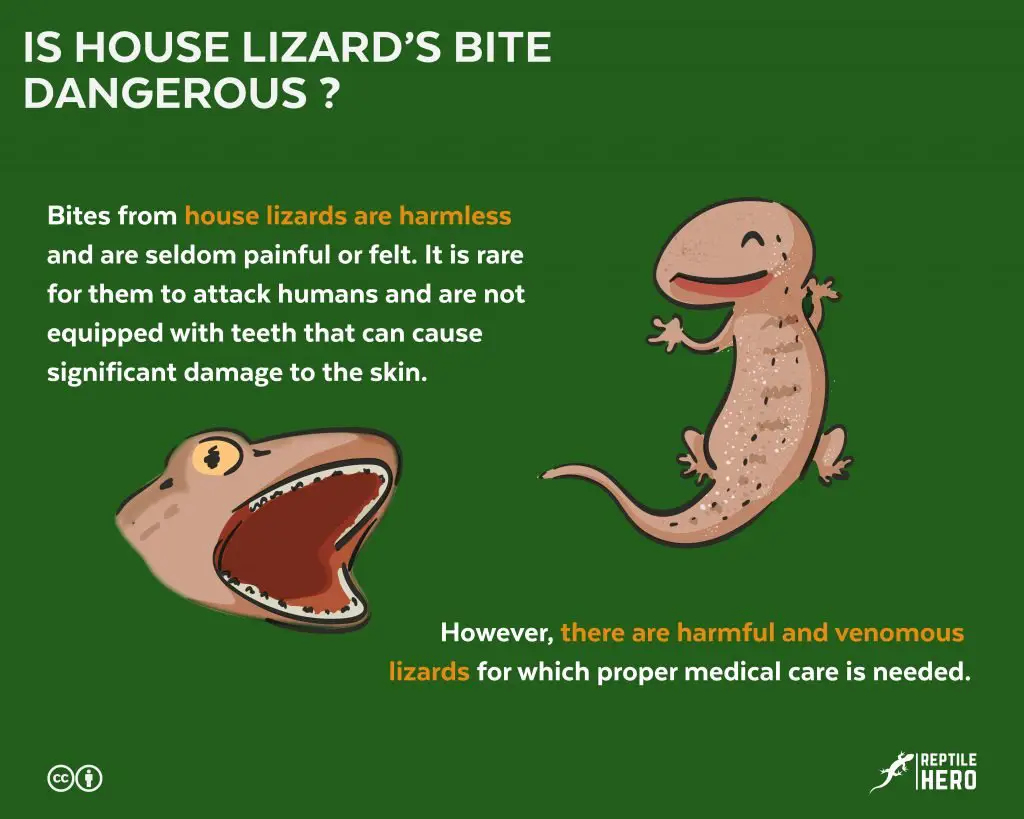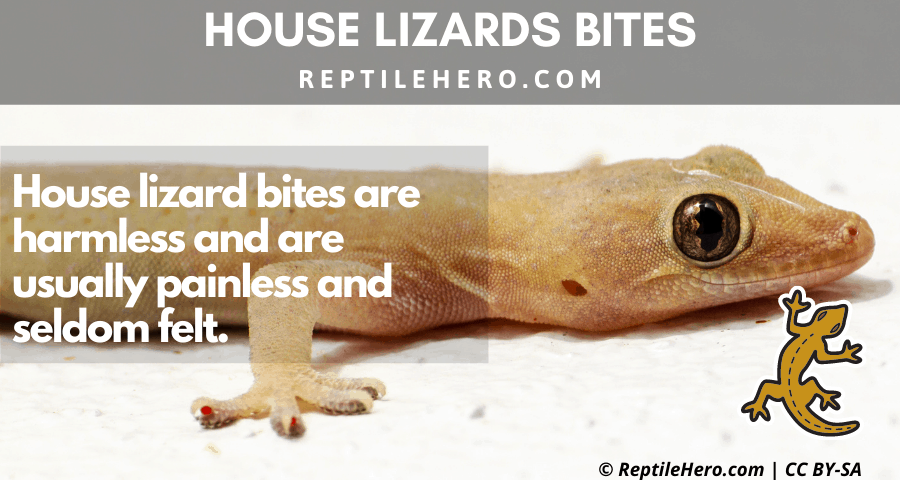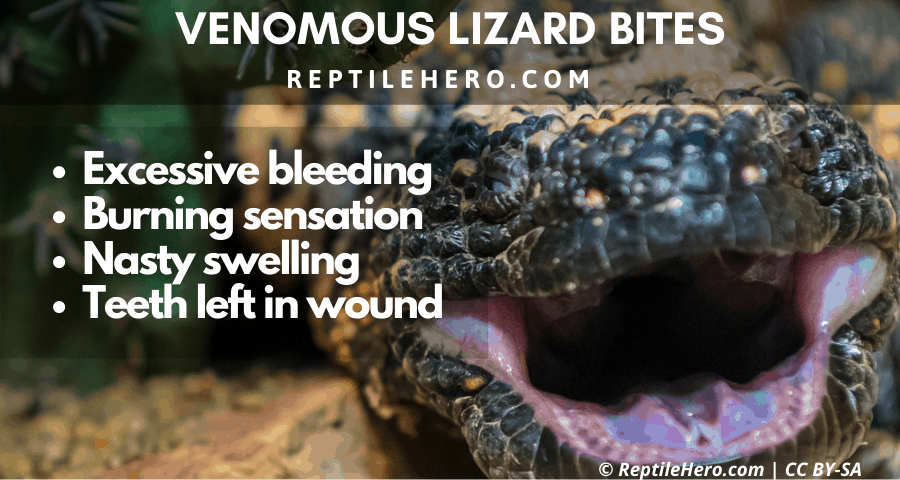Is House Gecko’s Bite Dangerous? [and What To Do]
It is usual for any home to have the occasional common house gecko roaming around– they are even welcomed by some because they help keep unwanted insects away. But what if one day, one of these house lizards decides to bite you?

Bites from house geckos (wall lizards) are harmless, do not cause any pain, and are not poisonous at all. It is rare for them to attack humans and this happened only if they feel in danger. They are not equipped with teeth that can cause significant damage to the skin.
Read on as we continue discussing this further.
How Harmful Is A House Lizard’s Bite?

House lizards are insectivores in nature. Because of this, the structure of their teeth and jaws are developed in a way that allows them to hunt, grasp, and chew on their common prey.
Examples of these are flies, mosquitoes, small cockroaches, and other insects that may be hiding in the corners of the average household.
This means two things that house lizards 1) they do not have the right mouth structure to hurt humans with a bite and 2) they do not consider us their prey.
First is that house lizards, like many other small and nonvenomous species, do not have a big enough mouth and a strong enough set of teeth to grab hold of much or even pierce through our skin. In many cases, lizard bites are considered gentle and are more shocking than painful. This is why such bites can usually be shrugged off or laughed off by the person who was bitten.
Here’s one video of a man who tried playing with a common household gecko while also trying to open its mouth:
The most that small lizards can do, like this five-lined skink, is leave a red mark or a slightly painful pinch where they have decided to bite you.
In some cases, nonvenomous lizards may also have minor scrapes and more obvious bite marks especially if you decide to pull away as they bite harder, but they are not usual causes for alarm.
Another thing to remember aside from their mouth structure is that most lizards do not consider humans as potential prey.
Lizards are more defensive and shy around humans, making it more common for them to run away when they are scared. They are even known to detach their tails in order to flee from threats, especially when they are grabbed by the tail.
This means that during the rare times that they do decide to attack you, they must have done so out of extreme stress that were also unable to run away. Lizards, like most reptiles, also give warning signs to those they see as a threat. They do this by opening their mouths and hissing, before proceeding to their bite.
In this video, the leopard gecko is held rather firmly as it is still in its shedding stage. During this period, lizards highly dislike being handled and are under significant discomfort due to their peeling skin.
Still, even here we can see that their bite is relatively painless and does not leave significant marks on the skin.
Lizards Bite That Can Harm
Bites from house geckos and most lizards are often harmless, but there are still a handful of lizards around which we should be more careful. Some lizards may be nonvenomous but are big enough to make you bleed or even create huge tears in the skin.
Consider this video of some kids from Florida testing the bites of the different lizards they caught:
A huge factor to consider here is the lizard’s size.
Crested anoles are known to be feisty little lizards with a sharper bite compared to other anoles in general due to their more robust head shape, giving them a certain “biting force” as their edge. Larger ones can cause deeper damage to the human skin. Bearded dragons, at times, can also draw blood when they decide to bite you.
What To Do After Lizard Bite?
First, wash the area with soap and warm water. Whether or not there is a wound present, it is still important to clean the area to avoid any potential infections from bacteria. Amphibians and reptiles are prone to carry salmonella, thus it is important to always wash your hands every time you handle them.
There is also the risk of house lizards carrying parasites and pathogens, and these may pose health risks to people sharing their homes with these otherwise harmless creatures.
Nonvenomous lizard bites respond well to home treatment and such is usually enough to prevent infections. In seeking medical care, especially for bites near the head and neck, wounds from nonvenomous lizards are often treated with topical antiseptic care as well as an evaluation of whether the victim is prone to tetanus or not.
Quinolone and other antibiotics may also be needed for wounds that are at risk for infections. After treatment, it is best to monitor the bitten area and take note of any signs such as the following:
- Excessive bleeding
- Growing burning sensation
- Nasty swelling
- Any teeth left in the wound
These may be signs of a poisonous bite, especially if you are unsure of the lizard species that bit you. Some other general signs to look out for are as follows:
- Weakness or fatigue
- Headache or dizziness
- Nausea and vomiting
- Excessive sweating
- Difficulty breathing
- Signs of a severe allergic reaction
In this case, your condition must be considered an emergency and you should immediately get proper medical attention.
Are There Venomous Lizards?

There are at least 100 species of lizards that can produce venom, and it is possible that a common ancestor for all venomous reptiles existed about 200 million years ago.
Bryan Fry, a scientist from the University of Melbourne, Australia, has led a team of researchers in conducting groundbreaking studies on how widespread venomous lizards really are contrary to popular belief, including how nine lizard toxins are even found to be shared with snakes.
Here something very curious.
Monitor lizards and iguanas are actually capable of producing venom. Being kept as pets in many households, it was previously believed that any sign of swelling or excessive bleeding from these lizards’ bites was only due to bacterial infections.
Iguanas are also herbivorous in nature, but the DNA analysis in the team’s study shows that the closest relatives of snakes are actually iguanians and anguimorphs, being the only two lineages to possess toxin-producing oral glands.
Iguanians include green iguanas, marine iguanas, and rhinoceros iguanas. Anguimorphs include the monitor lizard as well as the two most popular lizard species known to be venomous: the Gila Monster and the Mexican Beaded Lizard.
Both the Gila Monster and the Mexican Beaded Lizard are found within the U.S. and Mexico and are part of the family Helodermatidae. This relationship explains why the two lizards share almost similar features, only that the Mexican Beaded Lizard appears duller in color. Both are also carnivorous and have grooved teeth through which their venom flows.
The Largest Of All
Guinness World Records lists Gila Monsters as the most venomous lizard, its venom having LD50 (lethal dose) values as low as 0.4 mg/kg when injected into mice. It is noted, however, that even with this dosage, deaths related to the Gila Monster as well as the Mexican Beaded Lizard are very rare as the amount of venom in their bites are relatively small.
Another lizard considered to be dangerous is the Komodo Dragon. Native to Indonesia and growing up to 3 meters long, this is considered the largest lizard alive. These lizards are natural predators and would hunt almost any kind of meat, from deer, buffalos, and even other Komodo dragons. There have also been reports of them attacking and killing humans, but these are also very rare.
Since Komodo dragons eat carrion, it was previously believed that what kills their prey is the bacteria that comes from their mouth.
However, it has been discovered that they also have a venom of their own which reduces blood pressure, makes the victim lose blood faster, and also causes them to go into shock. This partnered with their bite-then-pull tactic tears the victim’s flesh more and pours the venom into the wound, making their attack deadlier.
Again, these venomous lizards do not bite unless they are handled or provoked. They also bite simply with teeth, not fangs, and very few deaths have been linked to lizard bites. Lastly, considering the locations where they are prominently found and how these areas also protect their species, it is very unlikely for us to come across one. Still, it doesn’t hurt to be vigilant and be prepared in case we do meet one and it chooses to bite us.
Consider the following first aid treatment for venomous bites:
- Isolate the lizard in order to avoid more bites
- Use an arm sling or other means to immobilize the bitten area
- Help the victim stay calm as you call for immediate help
A hospital would usually give antivenin or antivenom shots to the patient.
Is The Lizard Still Stuck?
When a lizard bites you, sometimes they can get stuck and won’t let go of biting you. In those rare cases, you can consider the following steps in removing them:
- Try loosening their bite with a stick or metal object
- Carefully hold a flame under the lizard’s chin
- Submerge the lizard in cold water
As always, it is important to be careful not to harm or kill the lizard as well as encourage any further bites from them.
Takeaways
- House lizards may bite at times, but they are harmless and do not usually hurt;
- Lizards, in general, are gentle and are not aggressive toward humans unless they are extremely provoked and stressed;
- There are a handful of bigger nonvenomous lizards that can draw blood when they bite, but home treatment is usually enough to prevent infection;
- There are known venomous lizards, but coming across one is very rare.


![7 Reasons Why Gecko Feet Are Not Sticky [and 2 Solutions]](https://www.reptilehero.com/wp-content/uploads/2021/03/G37-768x614.jpg)

![Are Geckos Sensitive To Sound? [4 Reasons, 9 Signs, 7 Tips]](https://www.reptilehero.com/wp-content/uploads/2021/03/G41-768x614.jpg)

